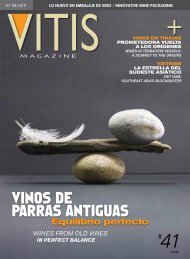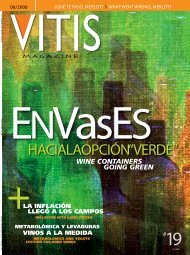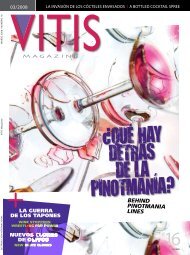You also want an ePaper? Increase the reach of your titles
YUMPU automatically turns print PDFs into web optimized ePapers that Google loves.
el ron no sólo se ha apropiado de la escena de la coctelería,<br />
sino que también amenaza con invadir el ámbito de la<br />
gastronomía de mantel largo. porque su capacidad de<br />
amalgamarse con distintos jugos o bebidas lo convierte<br />
en un trago ideal para quienes quieran acompañar sus<br />
comidas con otra cosa que no sea el tradicional vino.<br />
HArrieT nAHrWoLD<br />
Fotos / Photos: Jorge brantmayer<br />
Platos / Dishes: Chef Daniel Galaz<br />
e<br />
n la partida de nacimiento del ron ya<br />
venían inscritas las palabras alegría, tumulto<br />
y buena onda. porque eso es precisamente<br />
lo que significa el vocablo inglés rumbullion,<br />
que, se cree, estuvo en los orígenes del nombre<br />
de este destilado versátil y sabroso. Su historia<br />
está indisolublemente ligada al mar, y sus primeras huellas se pueden<br />
rastrear a partir del siglo XVi en correrías de piratas, en el comercio de<br />
esclavos y en innumerables crónicas viajeras posteriores a la conquista<br />
de américa. tal vez sea por eso que el ron tiene, aún hoy, esa aura de<br />
libertad asociada a la vida independiente de quienes surcaban los mares<br />
en busca de aventuras, oro y trascendencia.<br />
Y qué decir de la vocación fiestera del ron, sobre todo de uno de los<br />
más versátiles y consumidos en nuestro país, como es pampero. Cualquiera<br />
de los tragos de los que forma parte, inevitablemente traerá a<br />
la memoria la alegría contagiosa de celebraciones al son de la música<br />
caribeña y de sus ritmos cimbreantes. Ésa que con congas, güiros y<br />
maracas se ha hecho parte irresistible para todos quienes habitamos el<br />
continente americano.<br />
pero la historia del ron está también firmemente relacionada con el<br />
mojito y Camarones tailandeses<br />
el ron blanco es el que más se utiliza en la coctelería. adquiere<br />
su transparencia mediante filtraje con carbón. tiene un sabor<br />
más dulzón y afrutado, que combina bien con cualquier<br />
agregado que lo adelgace, como jugos de fruta o agua mineral<br />
mezclada con hierbabuena o menta. Con harto hielo, es la<br />
base clásica para preparar el mojito, que acompaña y refresca<br />
de maravilla platos frescos y livianos, como estos camarones<br />
tailandeses que preparó el chef daniel Galaz del restaurante ox.<br />
MojIto wIth thaI ShRIMp<br />
White rum is the most widely used in cocktail making. it gets its<br />
translucent appearance thru carbon filtration. its sweetish, fruity flavor<br />
is a great pairing for any ingredient that thins it, such as fruit juices or<br />
mineral water with a couple of mint leaves. Mixed with ice, it is the<br />
base for Mojito, a magnificent match for fresh, light dishes like these<br />
Thai shrimp prepared by chef Daniel Galaz from restaurant ox.<br />
Calling<br />
all rums<br />
Rum has not only taken the cocktail scene by storm; it<br />
also threatens to invade the realms of upscale dining<br />
too. Its astounding capacity to blend with different<br />
juices or beverages makes it the ideal drink for those<br />
who want to pair their meals with something other<br />
than wine.<br />
rum’s birth certificate came with the words joyful,<br />
tumultuous and funky printed on it. This is precisely the<br />
meaning of the word rumbullion, thought to be the origin<br />
of this versatile and tasty distillate’s name. its story is bound<br />
to the sea, and its first footprints can be tracked to the 16th<br />
century’s pirate skirmishes and adventures, slave trade and<br />
the countless traveler chronicles that followed the discovery<br />
and conquest of the new World. Maybe that is why rum<br />
still evokes the freedom associated to the independent spirit<br />
of those who sailed the seven seas in search of adventure,<br />
gold and glory.<br />
not to mention its partying nature, especially in the<br />
case of one of Chile’s best selling rums: Pampero. All<br />
drinks made with it inevitably reminisce the contagious<br />
liveliness of celebrations held to the beat of music from the<br />
Caribbean islands and its swing. The same music that has<br />
inundated the souls of the inhabitants of the Americas with<br />
its congas, maracas and guiros.<br />
but the story of rum is also inextricably linked to sweet<br />
water, the element without which the long voyages of<br />
pirates and conquistadors would not have been possible. in<br />
those days, one of the challenges facing sea travel was the<br />
availability of water during the whole journey from europe<br />
to the American continent. back then, the most readily<br />
available drinks were water and beer. once well into the<br />
voyage, the difference between the two began to fade:<br />
the water kept in barrels soon began to suffer the effects<br />
of algae proliferation, and beer, which did not include in<br />
its production process the modern techniques used today,<br />
became sour. That is why crewmembers and passengers<br />
alike drank beer first, saving water for last. They made<br />
▼ <strong>Vitis</strong> <strong>Magazine</strong> l novieMbre 2008 l 57






